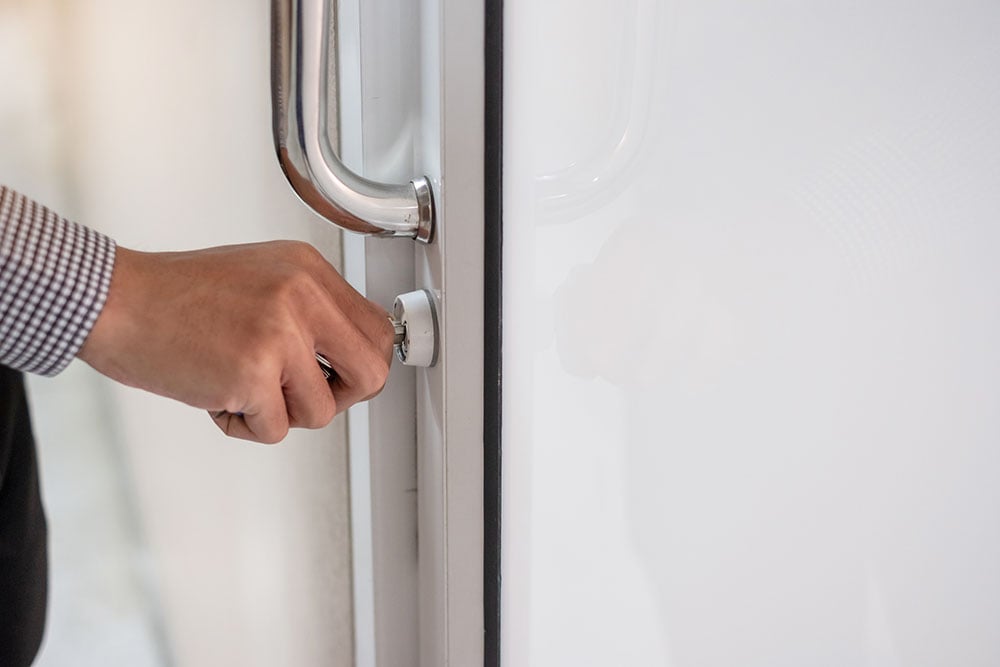Maintaining Security With a Master Key System

Master keys are magic, like having one ring to rule them all. That might be a hyperbolic claim, but a master key is pretty cool. Having a master key system can allow master key holders to carry fewer keys and gain access to multiple areas, locations, doors, etc. where others cannot. The key to maintaining security for your organization with a master key system is to treat those keys like the magic they are and guard them closely.
Your master key system should be as secure and thought-out as the rest of your key control. This is particularly important for businesses with multiple locations or facilities. Retail, grocery, and other multi-site organizations have the additional physical security challenge of restricting access in your facilities to only authorized key-holders by district, region, and so on, while still allowing for day-to-day business operations to continue unimpeded. With strategic and streamlined key control, you can implement a master key system that allows your administrators and other key holders the different levels of access they need to your locations while still maintaining security across the organization.
Master Keying a Multi-Site Facility
For retailers, grocers, and other multi-site organizations with numerous facilities, implementing a master key system can be challenging. As you put your key management system into place, you have to decide who has access at each authorization level and who has master key level access. You have to consider who has access across multiple site locations and who has access only to certain facilities and entry points. You need to take into account how many master keys you will need in circulation, who has them, what would cost if one of them is lost or stolen, and how that affects your overall security.
Key system administrators at multi-site facilities know the challenges of maintaining security while also managing day-to-day lock and key responsibilities. As key control experts, we are familiar with the process that companies go through to implement their own key control and master key systems. Let’s dive into master key control best practices to pull from as you update or implement your own master key system and other key control initiatives.
Crafting a Master Key System for Your Organization
Key control best practices for master key systems can help you establish and maintain security across multiple facilities. Taking the time to establish strong key control early on can streamline your master key system so that you’ll be able to efficiently and cost-effectively manage your physical security into the future. Here are four components of a master key system you will need to consider for your organization.
Restricted Keys
Restricted keys are important to the security of any key system because restricted keys cannot be duplicated. If keys cannot be duplicated, you can rest assured that all issued keys will remain the only issued keys in circulation. This is especially important for master key systems with keys that can gain access to more sensitive access points and/or several locations. Restricted keys that are also serial numbered can ensure that key tracking is simple and accurate. Restricted keys are an easy way to improve your security for all key holders and should be a top consideration for your master key system.
Streamline Your Master Key Holders
For retail, grocery and other multi-site organizations, you often have multiple managers at the regional, district or location levels who could have master key access. In this scenario, consider how you can best streamline your master key holders to limit unnecessary access. This can be accomplished though different master tiering.
Master keys aren’t a one-size-fits-all key control option. Similar to how you designate access levels across employees, you can have different types of access for master key holders. Sub-master keys can provide higher level access (complete access to a specific facility, for example) while not providing total access to everything. A grand master key, in comparison, can be issued only to a top-level administrator and provide complete access across all locations and entry points. Consider disaster recovery situations, lockdowns, and who would need timely access. Tiering your master keying can provide the access as needed on a more secure scale.
Be Prepared to Rekey
The reality of every organization is the occasional security breach. While strong key control practices can limit the number of security breaches that occur within your organization, keys are lost, break-ins happen, and you need to be prepared for a breach. Preparing for a security breach at the master key level means having an established plan for a quick response.
Depending on the lock and key hardware your organization is utilizing, you may need to call a locksmith immediately or ensure that you have key cores on-hand to change your locks. At the master key level, this can be expensive and time-consuming. The most efficient and cost-effective option currently available to multi-site facilities is user-rekeyable cores. An administrator can change the locks with a turn of a Step Change Key while leaving the key core installed in the lock hardware. This can be done several times with the same core, for the cost of a new set of master keys instead of the thousands of dollars typically spent to change out a master key system. InstaKey’s user-rekeyable cores can be rekeyed independently at the affected level, without affecting other levels or having to issue new keys to key holders in separate key levels. This means that you can rekey at the Master level for all doors while not having to replace any of the lower-level individual door keys. It’s magic.
Key Tracking Software
When talking about the physical security of an organization, we often focus on the actual locks and keys that keep your goods and facilities secure. But the tracking method you use to manage your key system is of equal importance. Your key control is only as effective as your ability to track all the locks, keys, and people in your organization. With multi-site organizations, the efficiency of your key tracking process can be a major determinant of how well your key system administrators can maintain security across locations.
Your key tracking software should allow for multiple key system administrators to have up-to-date access to your lock, key, and user information. While your tracking software can be available to administrators who need access to the information, provide specific access for the users who are updating, ordering, and reporting on key data. Similar to master keying use security levels in your tracking software, so you can control who changes what data, keep track of those changes by user, assign new keys more simply, address security breaches more quickly, and manage your day-to-day key control tasks more easily.
Comprehensive Key Control
Tier your key holder access, restrict your key duplication, prepare for the lock change event, and decentralize the tracking of keys to key holders – all are a good start to improving key control with a master key system. What’s left is finding a manufacturer to help design and implement all of this for you. There are so many lock and key manufacturers to choose from, but none of them create your comprehensive key control program that is designed to save you time, money and enhance facility security, except InstaKey. We’re not in the business of only selling locks and keys. It is our goal is to be your security partner, who works with you on tightening control of your key program through customizing your playbook with the best practices to make your key control simple.





.jpg?width=352&name=hands-open-a-door-key-lock-2021-08-29-14-35-30-utc%20(1).jpg)